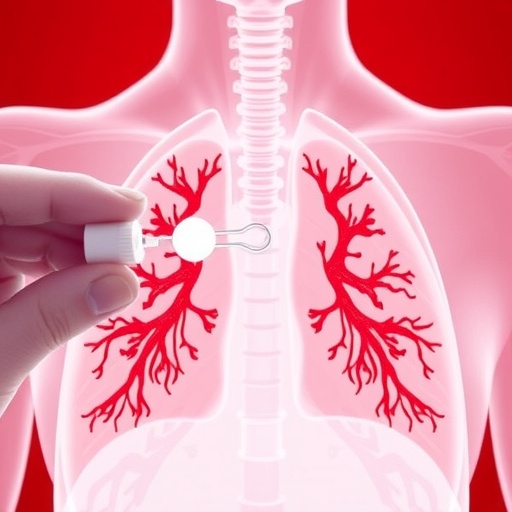In a groundbreaking advancement for the diagnosis of lower respiratory tract infections (LRTIs), researchers have identified a concise four-gene signature detectable in blood that can accurately exclude bacterial causes of these common and potentially severe infections. This research, recently published in Nature Communications, holds the promise to revolutionize clinical decision-making by refining the diagnostic process and minimizing unnecessary antibiotic use, a critical step in combating the global threat of antibiotic resistance. The ability to distinguish bacterial from viral LRTIs swiftly and with high precision has long been a challenge in medicine, often leading to over-prescription of antibiotics, increased healthcare costs, and adverse patient outcomes.
The team behind this study, led by Andrew R. Falsey and colleagues, developed an innovative molecular diagnostic tool using a transcriptomic approach that scrutinizes the host’s immune response at the gene expression level. Unlike traditional methods that rely heavily on microbiological cultures or radiographic evidence, this approach leverages the unique patterns of gene activity elicited by different types of infections to pinpoint whether a bacterial pathogen is responsible.
The clinical relevance of this four-gene signature lies in its specificity. Lower respiratory tract infections can be caused by a variety of pathogens, most notably bacteria and viruses, each of which triggers distinct immunological pathways in the host. By focusing on these gene expression variations in peripheral blood, the test effectively differentiates bacterial infections, which demand antibiotic treatment, from viral infections, where antibiotics are ineffective and unwarranted.
The study cohort included hundreds of adult patients presenting with symptoms consistent with LRTI, encompassing a diverse range of clinical severities and etiologies. This wide inclusion criteria were designed to mimic real-world clinical scenarios, providing robust evidence for the diagnostic utility of the gene signature across varied presentations. Comprehensive clinical evaluations, alongside conventional microbiological assessments, served as the reference standard against which the gene signature’s performance was measured.
Technological advancements in high-throughput RNA sequencing played a pivotal role in this research. The initial genome-wide screening identified thousands of transcripts differing between bacterial and viral infections, from which the team meticulously distilled a minimal set of four genes. This minimalist approach increases feasibility for clinical application, facilitating rapid, cost-effective testing that can be integrated into routine workflows.
One key gene among this signature is known to mediate pathways linked closely to bacterial recognition and immune activation. Its differential expression pattern provides a molecular fingerprint that robustly correlates with bacterial infection presence. The remaining three genes complement this signature by further refining the discrimination power, collectively enhancing the test’s sensitivity and specificity.
The translational implications of this research are vast. In emergency departments and outpatient clinics, where rapid and accurate diagnosis impacts treatment decisions, this test could drastically reduce the empirical use of broad-spectrum antibiotics. By confidently ruling out bacterial infection, clinicians can withhold antibiotics, limiting needless exposure and the associated side effects such as microbiome disruption and fostering antimicrobial resistance.
Moreover, the diagnostic accuracy helps prioritize patients who genuinely require antibacterial therapy and close monitoring, improving resource allocation within health systems. The test’s reliance on peripheral blood samples — which are minimally invasive and widely accessible — further underscores its practicality for widespread implementation.
This novel diagnostic tool holds promise in global health contexts, particularly in resource-limited settings where sophisticated microbiological infrastructure may be lacking. With further development and validation, the four-gene signature assay could be adapted for point-of-care devices, enabling timely diagnosis and appropriate intervention even outside tertiary care centers.
From a mechanistic perspective, the study also sheds light on the interplay between host immune pathways in response to different infectious stimuli. The distinct gene expression profiles identified highlight critical aspects of host-pathogen interaction, offering avenues for future research into immune modulation and therapeutic targets.
The authors underscore the importance of integrating molecular diagnostics with clinical judgment, emphasizing that while the four-gene signature offers significant improvements, it is an adjunct rather than a standalone tool. Complementary clinical data remains essential to contextualize test results within the broader clinical picture.
As antibiotic resistance escalates into a pressing global health crisis, innovations such as this genetic signature provide a powerful weapon to preserve antibiotic efficacy. By accurately distinguishing bacterial from viral infections, this approach allows for precision medicine strategies that align treatment with underlying pathology, optimizing patient outcomes while safeguarding public health.
The study makes a compelling case for the next generation of diagnostics, which harness the host’s biological response rather than solely focusing on pathogen detection. This paradigm shift could redefine infectious disease management, introducing faster, more precise methods that better capture the complexity of infections.
Future directions will involve scaling up validation efforts across diverse populations, infection types, and healthcare settings to confirm reproducibility and generalizability. Moreover, efforts toward regulatory approval and commercial assay development will be critical steps toward clinical adoption.
In summary, this research exemplifies how molecular diagnostics can transform infectious disease diagnosis by delivering rapid, accurate, and actionable information from a simple blood test. The four-gene signature represents an elegant solution to a long-standing diagnostic dilemma in respiratory infections, poised to reduce antibiotic misuse and improve patient care worldwide. As the medical community embraces precision medicine and personalized approaches, tools like this pave the way for more targeted and responsible healthcare practices.
Subject of Research:
Diagnostic development for differentiating bacterial versus viral lower respiratory tract infections using host blood gene expression.
Article Title:
A four-gene signature from blood to exclude bacterial etiology of lower respiratory tract infection in adults.
Article References:
Falsey, A.R., Peterson, D.R., Walsh, E.E. et al. A four-gene signature from blood to exclude bacterial etiology of lower respiratory tract infection in adults. Nat Commun 16, 10383 (2025). https://doi.org/10.1038/s41467-025-65361-3
Image Credits:
AI Generated




